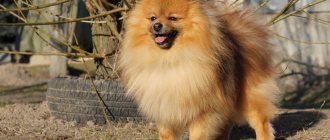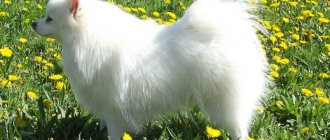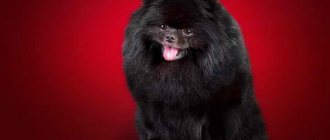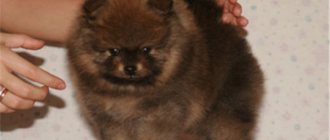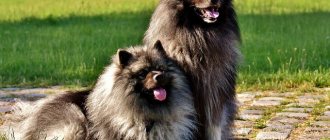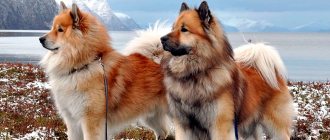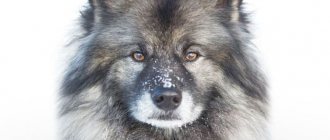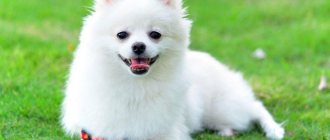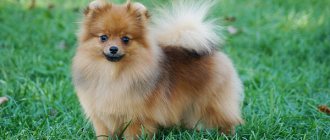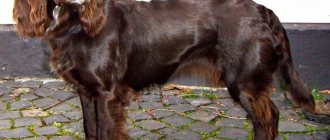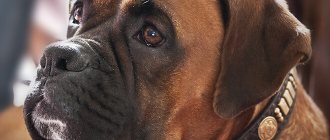| Origin: | Germany |
| Usage: | companion, watchman |
| Color: | various |
| Dimensions: | 20-55 cm |
| Lifespan: | 15 years |
The German Spitz is absolutely charming. He resembles a cross between a fox, a bear cub and a lion. And behind the sweet appearance hides a fearless guard, a curious mischief-maker and an understanding companion. This fur ball with triangular ears and beady eyes has captivated thousands of people since ancient Rome and continues to win the love of millions of dog lovers today.
Features of the German Spitz breed
In ancient times, large German Spitz dogs were used as guards, herding sheep, and guarding houses. The breed was formed without human intervention until the 18th century. Later, Spitz dogs gained recognition among court ladies as a decorative breed.
The dogs were larger than modern representatives. They captivated their owners with their intelligence, loyalty, easy-going nature and cheerful disposition. At the same time, being good watchmen and security guards, German Spitz dogs were cute and playful.
Thick, beautiful coat protects the dog from the cold. The dog tolerates high humidity well. He enjoys playing outside and running after toys. Easy to train, loves to swim in the water.
The dog is smart and smart. Attached to the owner with all her soul. Security and watchdog qualities are at a high level even in the smallest representatives of the breed. The dog's calm and balanced character allows him to get along with children and other animals.
Dwarf German cuties retain the same qualities as large dogs.
History of appearance
Representatives of the European peat or swamp dog are recognized as the ancestor of the breed. Their distant ancestors are visible in images from the times of Ancient Greece and Ancient Rome. They were larger than modern specimens, but smaller than other guard and herding dogs. They did not take up much space, ate little, and were faithful and devoted to their owners. This earned them a place in people's hearts.
Ancient representatives of the breed gradually moved throughout Europe at different stages of development. Historical roots arose in Scandinavia, along the entire coast of the Baltic Sea, reached the southern part of Europe, crossed the English Channel and ended up in Great Britain.
Actual country of origin of the breed
The remains of the ancestor of the Neolithic peat dog were discovered during excavations in the territory of modern Switzerland. This is the oldest breed on the European continent.
The name was assigned to the dogs only thanks to the breeding and development of the breed in Germany in the 18th century. The first breeding work was carried out in Denmark and Holland in the 16th century. In fact, one of the Scandinavian countries should be considered the birthplace of the breed.
Difference from the Pomeranian
The Pomeranian dwarf was bred much later than its large and medium-sized relatives. Queen Victoria of Great Britain began work on breeding dwarf dogs at the end of the 19th century. The final standard for miniature oranges was formed only in the middle of the last century.
Description of breed standards
The International Canine Federation recognizes 5 standards for the German Spitz breed:
- large or wolfish;
- big;
- average;
- small;
- dwarf.
Height varies from 18 cm to 50 cm. The weight of a large purebred male reaches 30 kg, girls are slightly less. A dwarf orange weighs on average about 2 kg.
Despite significant differences in height and weight, the basic breed standards are typical for all representatives of German Spitz.
The body is square, compact, proportional to height. The chest is powerful and convex. The abdomen is retracted, the neck is medium-short, widening towards the base. The paws are straight, the pads are rounded, tightly compressed, the claws and pads are black (except for brown).
The muzzle is slightly elongated, pointed towards the nose, similar to a fox. The eyes are round, black (except for brown), slightly oblique. The ears are erect, triangle-shaped, and set high. There are 42 teeth; Pomeranians may have no premolars; they have a scissor bite. The black lips are smooth, pressed tightly to the teeth, without jowls.
The tail is curled and lies on the back. The guard coat is long, straight, with a dense, dense undercoat. The movements are confident and springy.
Standards for the exhibition
A dog may not be allowed to attend the exhibition:
- cowardly or, conversely, too aggressive;
- with defects in appearance;
- with behavioral disorders;
- with bulging eyes;
- with an unovergrown fontanel;
- with any malocclusion;
- with non-standing ears;
- with a nose, lips and eyelids that are not black (or brown);
- with the absence of the correct pattern on the face of the Keeshond;
- with non-standard colors not included in the breed list.
Colors and what a German Spitz looks like and puppies of this breed
Long hair with a thick, dense undercoat is the main advantage of the German Spitz. Depending on the size of the dog, acceptable colors range from white to black. The Wolfspitz is the largest representative of the breed and comes in only one color – wolf grey-zoned. The Grossspitz has three coat colors: white, brown and black. Medium, small and dwarf Spitz representatives have white, cream, red, brown, bi-color, black, gray-fawn, black-fawn and tri-color. Sable, brindle and merle colors are allowed in oranges.
The fluffy collar on the neck and fluffy pants on the hind legs distinguish all varieties of German Spitz from other dog breeds.
The final coat color of complex colors is formed only after the first molt. Puppies of gray-fawn, black-fawn, as well as red, beige and black colors often do not have an even color for the first three months of life. Only by 4-6 months the color changes to standard. The puppy begins to look like a German Spitz, taking on the features of a dog of its own breed.
For a two-color and three-color pet, the main color is always white.
White color
The most popular color remains white. According to standards, the color should be even without darkening, without islands of beige color, impurities and individual hairs of other colors. Only a light cream shade behind the ears is acceptable.
Among Spitz dogs of all categories, white German “fluffies” are in demand in large, medium and small groups, despite the difficult care of their coat and the peculiarities of keeping it clean.
Keeping the white fur squeaky clean is made difficult by the fact that it is not recommended to bathe the animal often. Buying clothes, shoes, special dry shampoos for washing your pet will become an additional expense. But this does not stop lovers of white color.
The appearance of an absolutely white coat gives the dog a noble, aristocratic appearance. Only the nose, eyes and claws are painted black. Since ancient times, white has remained the most popular color.
Black color
The black color of the coat attracts with its monotony. Completely black individuals are amazingly beautiful and attractive. Deep black has become a popular color for the German Spitz breed. Exhibition specimens are completely black, including the nose, eyes, claws and paw pads, looking impressive.
Red color
The peculiarity of the red or orange color is its real rich manifestation after the dog’s first molt. Until this time, the puppy's coat color may appear lighter than the usual orange shade. The undercoat will also not immediately meet exhibition requirements.
According to breed standards, the collar, top of the hind legs and tail may be lighter than the base tone.
Sable color
Sable dogs are very attractive. Transitions of gray, dark gray and blue shades create the effect of sable skin. The color is not recognized as an exhibition option in all countries.
Other colors
If the Keeshond is allowed for exhibitions only in one color, silver-gray, then the variety of colors of the medium, small and dwarf German Spitz is represented by gray, brown, cream shades and spotted multi-colors.
For brown dogs, an exception is made for the color of the nose, eyes, and claws. They should be the same color as the fur - brown.
Spotted coloration refers to individual spots of color on a mostly white background. The stains should be uniform in color, without inclusions.
Features of behavior
The balanced character of the German Spitz is especially noticeable among representatives of large species. Small and dwarf pets are more emotional. But by paying attention to raising a pet and corrective classes, an excellent result is achieved in adapting the animal to life in society.
Usually a German Spitz behaves warily with a stranger and does not allow him to approach his owner. Without proper training, a dog can become aggressive, scare away by barking, and even attack a stranger, trying to bite. We must not forget that the genetics of the breed are dominated not by decorative qualities, but by protective qualities.
German Spitz attitude towards children
The cute, good-natured appearance of the dwarf Spitz is misleading. You want to hug the dog and ruffle its soft fur. The idea that such treatment of an animal is possible is erroneous. The free and proud character of the German Spitz requires respectful treatment regardless of size.
A child unknowingly mistaking a small dog for a soft toy can cause the dog to defend itself. Small children should not be left alone with a German Spitz without supervision. The dog will quickly find a common language with the owner’s child and will put up with his pranks, but within reasonable limits. Children should not play with someone else's dog to avoid getting into trouble.
How to train correctly
The Spitz is easy to train, so you can easily raise a cultured and docile animal on your own. You just need to follow a few rules:
- Play with puppies carefully, do not pull limbs, do not cause pain.
- Keep it on a leash, as in a fit of curiosity the pet can jump out onto the roadway.
- When training, use only the “carrot” method: encourage, praise, give treats.
Character and habits of German Spitz
The Spitz's cheerful and good-natured disposition has made him popular all over the world. When getting a furry pet, you need to take into account the characteristics of its character.
The dog's active temperament requires long walks and physical activity.
The devotion of German Spitz dogs is so great that, being without their owner for a long time, they can get sick from boredom.
The puppy is smart, easy to train, and quickly remembers commands. The guard and watchman skills of this breed have been preserved even after several centuries of breeding work.
Maintenance and care
Cute German “charms” are suitable for keeping in an apartment or in a house. They do not take up much space and find a common language with other animals.
The decorative German dog needs constant care. For this, hygiene items are purchased: a comb, a slicker brush, a nail clipper, a nail file, a warm blanket for a place or a mattress bought in a store, shampoo, conditioner, lotion for treating ears, eye cleanser, bowls for food and water, toys.
The decorative German small Spitz requires a more responsible approach to maintenance and care than its large and medium-sized relatives.
Diet
During the first 2-3 weeks of the puppy’s adaptation to new conditions, it is advisable to feed the baby the food that he is accustomed to in the kennel, gradually introducing into the diet the foods that you are going to feed the dog.
It is advisable to feed a 2-4 month old puppy every 4 hours. From the age of 5 months, you need to transfer the puppy to 4 meals a day. From 8 months, it is already enough for a Spitz to eat 3 times a day. From the age of 1 year, the dog should switch to a 2-time feeding regimen.
Spitzes need to add raw and boiled vegetables, raw meat, cereals, sea fish and cottage cheese to their diet. Or switch to ready-made balanced premium food.
Overfeeding a dog is unacceptable. It can lead to obesity in your pet, and even undermine its health.
Maintaining the physical condition of the German Spitz is important to maintaining the breed standard, which is facilitated by a strict feeding schedule and a balanced diet.
Wool and care
The main advantage of the German Spitz is considered to be its thick, long hair with a dense undercoat, which gives the animal a cute and attractive appearance. The coat needs constant care.
It is advisable to comb the German “handsome” at least once a week with a slicker brush and a wide-toothed comb. During autumn and spring shedding, you can scratch it daily with a massage brush or slicker brush.
It is imperative to monitor the appearance of tangles and promptly cut or comb out stuck together lumps of hair. Excessive hair loss and the appearance of bald patches can serve as a signal to change your diet. Long-term hair loss and the appearance of bald spots on the skin indicate serious disturbances in the functioning of the body and health problems. You should contact your veterinarian for advice and treatment.
The owner needs to accustom the puppy to the comb as early as possible, so that in the future the procedure does not bring unpleasant moments.
Haircut and grooming
The coat of the German Spitz is capricious. Damage to the undercoat threatens to disrupt hair growth. Grooming and complex haircuts are best left to a specialist. Especially before the exhibition. You can independently trim protruding hairs and simply trim small tangles.
Eye care
The black button eyes (or brown ones of the same color) give a special charm to the face of the German Spitz. Spitz eyes are indicators of the dog’s health. A little tearing is acceptable and does not cause concern about the health of the pet. It is enough to wipe your eyes daily with special products. Excessive tearing indicates a disruption in the functioning of the body. It can be caused by allergies, poor diet, poor gastrointestinal function and retinal detachment. This is a signal to contact the veterinarian.
Teeth and health
The German Spitz has large and medium-sized teeth, very strong, and do not require additional care. Standard procedures and brushing your teeth with special edible bones are enough. Small representatives of German Spitz, including Pomeranians, require careful attention when changing baby teeth. The deep root system makes it difficult to form a correct bite. Sometimes veterinary intervention is necessary.
Tartar buildup can become a problem if you don't pay attention to brushing your German dog's teeth. It is recommended to start the procedure after the change of baby teeth, which ends at the age of 8-9 months.
Ear health
You should carefully monitor the condition of your German Spitz's ears. A daily inspection won't hurt. About once a week you need to wipe the ear with a cotton swab dipped in lotion. Clean your ears with special products and trim excess hairs.
Redness of the ear, restless behavior of the dog: head shaking or scratching of the ears are signs of ear diseases that require consultation with a veterinarian.
Nail care
The agility and speed of the German Spitz helps the larger representatives of the species maintain their claws in the desired shape. It is recommended to trim the nails once a month and sharpen them with a soft file. In dwarf dogs with small height and weight, the claws themselves do not grind down to the required length. Therefore, it is better to carry out trimming at least 3-4 times a month. Then carefully file away the sharp edges.
Water treatments
Frequent bathing has a bad effect on the condition of the animal’s skin and the thickness of the undercoat. A German “fluffy” can take a bath no more than once every two months or as needed. You should wipe your paws with a damp cloth after every walk. To prevent the pads from cracking due to dryness, you need to rub a softening lotion into the paws.
Walks
It is recommended to walk a puppy under 6 months of age 4-5 times a day. As you get older, the frequency of walking decreases. An adult dog is walked 2 times a day. Large and medium-sized Spitz can calmly tolerate an interval of 12 hours. The average duration of walks is from 40 minutes to 2 hours.
Dwarf German Spitz dogs, including Pomeranians, have a bladder that is too small. Long breaks between walks are not easy for dogs. If walking three times a day is not possible, then the way out would be to accustom the baby to a cat litter box or a disposable diaper.
Long one and a half hour walks are useful for an agile athlete who loves playing with a ball. The lively activity and mobility of the animal require constant loads. Having splashed out his energy on a walk, the dog will become calm and sweet at home.
Care
In the eyes of a puppy who has just arrived there, the apartment looks like an unfamiliar, alien world! Every careless movement can be dangerous for the puppy. To protect your pet from the dangers that await him and possible herbs, you should follow the recommendations. Purchasing a dog enclosure will be an excellent solution if the puppy is left alone in the apartment. This is his cozy corner, where there is everything necessary for waiting for the owners. The main thing is that the baby is safe and his games and pranks will not lead to damage to property, because boredom can make the baby chew wires or bite off a corner of the wallpaper.
To prevent the puppy from getting hurt, his play area needs to be fenced off
A comfortable bed and a tray with filling should be in the enclosure.
A bowl of water and a portion of food should be available to the dog. While waiting, you can put a bone from the veins. It is better not to leave toys and balls in the enclosure; the dog can bite off a piece of rubber and swallow it, and this is a foreign object in the stomach, which is very dangerous for the baby.
After a long wait, when the owner returns home, it is necessary to play with the dog and take it for a walk. You need to take a leash and collar, toys and treats with you. In damp, rainy weather, you can put a Bolognese overall on your puppy - it will protect the puppy’s coat from contamination, and you won’t have to wash the baby, but just wipe his paws with a damp towel.
Playing with a puppy, communication and care will be an excellent incentive for a companion dog to grow up. Loud barking and prolonged howling occurs in unbalanced, neglected dogs.
Diet features
The dog's miniature size does not allow it to swallow large pieces of food. Meat and vegetables must be cut into pieces. Chicken, lamb or beef should make up 70% of the diet, vegetables and cereals - 30%. Buns, sweets, and cakes should not be fed to Spitz dogs.
During the period of active growth of the Spitz from 4-8 months, it is necessary to add vitamins to the diet for puppies of small breeds. During the period of active molting in a dog, brushing and adding sea fish to the diet will help the body cope with the change in coat.
During the molting period, add sea fish to your pet's diet.
A fur coat is an indicator of a healthy pet and proper feeding; a lack of vitamins A, E, F will affect the coat - it will become dull and mat.
Hygiene
An active and playful dog with sparkling eyes and fluffy fur requires the owner’s time not only for games, but also for care:
- You need to brush your dog twice a week.
- Wash with shampoo – once every three months.
- Wipe your eyes and inspect your ears – once every three days.
- In spring and early summer - treat your dog for ticks.
Tendency to diseases
Dwarf varieties of German Spitz, in the selection of which attention was paid to appearance, are susceptible to certain types of diseases. These include: joint weakness, urolithiasis, gastrointestinal problems, laryngeal cough, eye abnormalities, skin diseases.
With proper attention to your pet's well-being, most health problems can be avoided. Constant observation by a veterinarian, proper nutrition, constant care and physical activity will make you forget about diseases.
Large representatives of the breed were least subjected to selection and retained excellent health. But care, prevention, and maintaining good physical shape are no less important to them than to their smaller relatives.
Basics of training and behavior correction
A smart pet already from 6 months learns to carry out the owner’s basic commands. By the age of two, the dog becomes a full-fledged member of the family and a trained guard, knowing and following the commands “Come to me”, “Sit”, “Lie down”, “Voice”, “Near” and “Fu”.
It is possible to train in agility (optional), or overcoming dog obstacles. A penchant for play, quick learning, mobility, and a desire to dominate will lead your pet to achievements in an interesting, new direction of performance.
Early socialization of a German Spitz puppy will help relieve excess aggressiveness, teach him how to communicate with other dogs, and provide an outlet for energy.
For the German Spitz breed, the time spent on education and care will result in a calm, measured life with an obedient and healthy animal.
List of best nicknames
When you decide to buy a pet, you should not hesitate to choose a name for it. The sooner the owner of the dog decides, the sooner it will understand and get used to the commands.
Sometimes the family does not know exactly what to name the puppy until the last moment. Many people want to understand this the first time they see it. In such a case, it is recommended to go after the dog already knowing several nicknames.
Top 10 popular nicknames for girls:
- Gloria,
- Lyme,
- Linda;
- Silvia;
- Desi;
- Tina;
- Squirrel;
- Betta;
- Lada;
- Rita.
For boys:
- Alex;
- Barley;
- Mauro;
- Cross;
- Leo;
- Oscor;
- Punch;
- Tyler;
- Tony;
- Yashka.
German Spitz nurseries
The German Spitz breed is bred in three directions: pet class, brit class and show class. Before purchasing a puppy, it is important to decide for what purpose you are getting a pet. Dream of winning at exhibitions? Then you need to contact breeders who breed show-class dogs. If you want to breed German Spitz yourself, then you need to choose a dog from the Brit category. If you need a friend and companion, then you need to pay attention to puppies bred for pet standards.
You should only buy a puppy from trusted breeders.
Story
There is no exact version of the origin of the Spitz breed. What is known is that in Europe it is considered the oldest.
According to one assumption, the Spitz is a descendant of a peat dog, whose remains were discovered during archaeological excavations in 1860. The age of the found skeletons was assigned to the “Neolithic” period.
Dog breeding began already in the 15th century. But then these fluffy balls were different. Work on the species and natural evolution have made the breed what it looks like today.
The south of the Baltic is considered the homeland of dogs. Where they were brought in the 10th century. by the ancient Vikings, and for the next 3 centuries they carried out guard duty and also worked as shepherds in the fields. But later, aristocratic families began to have furry animals on their estates as companions.
Many great people preferred Spitz dogs. Their presence nearby helped create masterpieces of music, painting, and literature.
Positive and negative characteristics
There are both positive and negative aspects in the character and behavior of the German Spitz. Before purchasing a puppy, you must carefully study all the nuances inherent in the chosen breed.
The advantages of German dogs include:
- active, curious, playful, disposition;
- devotion and fidelity;
- excellent security qualities;
- loyal attitude towards children and animals;
- obedient, easy to train;
- insensitive to weather conditions;
- adapts to the owner’s habits, sensitively capturing the person’s mood.
The disadvantages mean some features:
- barks a lot if behavior is not corrected;
- may show aggression towards strangers, which can be corrected by proper upbringing;
- strives to dominate;
- prone to certain types of diseases.
Characteristics of height and weight
There are 5 types of German classic representatives of the breed:
- Wolfspitz (Keeshond). The largest representative of the breed. It has only one acceptable coat color - zone-gray with silver and black transitions. The height at the withers of an adult male reaches 55 cm, and the weight reaches 30 kg.
- Grossspitz, or large German. Available in white, brown and black colors. Height at the withers is from 42 for a girl and up to 50 cm for a boy with an average weight of 15-18 kg.
- Mittelspitz, medium. The coat color can be white, red, brown, black, fawn-gray, fawn-black. Other colors allowed by the breed standard are also possible. It grows no higher than 35-40 cm, gaining weight no more than 11 kg.
- Kleinspitz, or small Spitz. The color includes all solid colors, bicolor and fawn. At the withers it grows to 23-29 cm and weighs between 8-10 kg.
- Miniature Spitz, dwarf or Pomeranian. Acceptable colors are white, cream, brown, gray-fawn, black-fawn, black, and bicolor. The American Canine Federation also recognizes sable, brindle and tricolor colors. The height of the orange is no more than 22 cm, weight from 1.5 kg to 3.5 kg.
The height at the withers of all German Spitz, regardless of size, is equal to the length of the body in a 1:1 ratio.
Lifespan
The maximum age of a Spitz directly depends on its size. The larger the individual, and the greater the weight of the adult dog, the longer it will please the owner. There are many factors that influence longevity.
The average life expectancy of German Spitz is 6-15 years. In some cases - up to 20.
What can shorten a dog's years:
- Urban environment. A Spitz, like any animal, will live longer away from noisy highways and city bustle.
- Genetic diseases. What was passed on to the puppy from the parents. The health factor is important.
- Fractures, dislocations. You should be careful about the condition of your pet's bones. The Spitz skeleton is very fragile and a limb can easily be damaged.
- Fractures, dislocations. Lack of vitamins and minerals. An unbalanced diet will lead to a general weakening of the immune system.
- Stress. Spitz dogs have a weak nervous system. They are subject to overload and are acutely sensitive to separation from their owner.
- Lack of medical care. If a dog is not vaccinated and its health is not monitored, this can affect its quality of life.
- Overheat. A very dangerous and harmful factor. The dog should not be allowed to remain in the heat for a long time. Due to the length of their coat, Pomeranians are susceptible to heat stroke.
Buying a puppy
You need to contact professional breeders. Some colors of German “charms” are visible only after the first molt, which occurs at 4-6 months of age. When examined, the puppy should be active, cheerful, and curious. The nose is black, the eyes are lively black. For the brown color, the eyes and nose are brown. A responsible approach to buying a German Spitz dog is manifested in the subsequent care of the puppy.
Flaws
A Spitz is not suitable for families with small children - a dog that demands attention with its ringing bark can scare the child. In active games, a child can harm a mini dog. If a Spitz experiences pain, it may become aggressive towards children.
Very busy people will not be able to devote time to walking and caring for their dog. Howling and barking will not please the neighbors of a lonely Spitz. And a nervous dog can begin to spoil the things of a busy owner, which will cause an attack of indignation and conflict.
Spitz can't stand being alone for long periods of time
The cocky character of the dwarf Spitz does not allow him to run without a leash. Boys will provoke other dogs into fighting. Girls snap at strange dogs when they want to get to know each other.
The high cost of a dog and the large amount of time spent on care and training are also a deterrent to buying a puppy.
Price category
Buying a classic German Spitz puppy is not a cheap pleasure. The cost depends on many factors: color, pedigree and availability of documents. Particularly valued in the German Spitz breed is a white show-class puppy. White color without impurities or spots is considered the standard color for dwarf Spitz varieties. Girls are more expensive.
Cost of a puppy with documents
A German Spitz puppy with a pedigree, depending on the achievements of the parents, costs from 30 thousand rubles and more. The price of a show-class puppy can reach one hundred thousand rubles.
Cost of a puppy without documents
A Spitz without documents is inexpensive: from 10 thousand rubles to 35 thousand rubles. He will not be able to participate in exhibitions, but he will not be inferior in loyalty and devotion to his owner to his more expensive relatives. Subject to purchase from trusted breeders.
Breeding
German Spitz dogs are bred in their historical homeland in Germany.
But Russia is not lagging behind Europe. Breeders are attracted to this breed because of its high profitability. For one puppy they give up to 70 thousand rubles.
But the presence of pitfalls in the process itself forces many to abandon this venture. Miniature Spitz puppies are very demanding and gentle to care for. In addition, small dogs are difficult to keep.
Below is the minimum cost item for high-quality Spitz breeding. (prices in the table are given in rubles):
| Advertising and promotion | 30 000 |
| Puppy cost | 60 000 |
| Feed | 15 000 |
| Medical service | 3 000 |
| Access to exhibitions | 15 000 |
| Appearance care | 10 000 |
| Keeping a dog | 5 000 |
| Dog handler services | 10 000 |
Interesting information
Interesting information about the German Spitz:
- Judging by the thick and dense coat and abundant undercoat, we can conclude that the northern Scandinavian countries should be considered the birthplace of the German Spitz.
- Breeding small dwarf species of Spitz did not change its character. He remained a brave dog, an excellent guard and a devoted friend to his owner.
- Spitz means “sharp” in German.
- In Japan, a separate subspecies of Spitz was bred, wearing only white coloring. It is similar to its cousins, slightly larger than Pomeranians and hardly barks.
- In Canada and the United States, Pomeranians and Keeshonds are recognized as separate breeds.
The most famous German Spitz in history:
- Queen Victoria of England introduced the fashion for small dogs at court. She received as a gift a small dog named Marco, thanks to whom the breeding of dwarf dogs called Pomeranians began.
- The Russian Emperor Paul I had a favorite German Spitz, which the emperor called Spitz.
- The famous physicist Isaac Newton loved his Spitz named Piece so much that he forgave him, the child, all his faults.
- One of the three dogs that were rescued during the sinking of the Titanic was a dwarf Spitz, which the owner saved by hiding it in the boat under her clothes.
Education or training?
The owner of a Spitz does not have any difficulties with training if the owner’s actions are constant and understandable to the dog. The Spitz begins to look into the owner's eyes and guess his desires at two months. Excellent reactions and constant activity will also be a good basis for motivating the dog. The small size of even an adult dog will allow the owner to walk with the pet without jerking or falling.
The owners consider the only drawback to be the dog's loud barking in response to any incomprehensible situation or to any unfamiliar stimulus. If you respond promptly and correctly to a loud voice, then this habit can be changed.
The dog is easy to train. She is very smart and active, which helps a lot in learning. But since the dog is very energetic, it is more suitable for active people. It is necessary to walk the dog so that the dog can burn off energy and run around. Otherwise, all her energy will turn into aggression, and this is undesirable for such a cute dog. And then I don’t know how to deal with aggression. I have never regretted my choice) We wake up together every morning and enjoy the new day!
Arina
The German Spitz is capable of complex training, on a par with the Malinois or German Shepherd. There are obedience courses, and for such nimble dogs there are more interesting types of training. Agility, Patch and Go, circus training, dancing with a dog - these types of activities allow the dog to always be in excellent shape and in a good mood.
